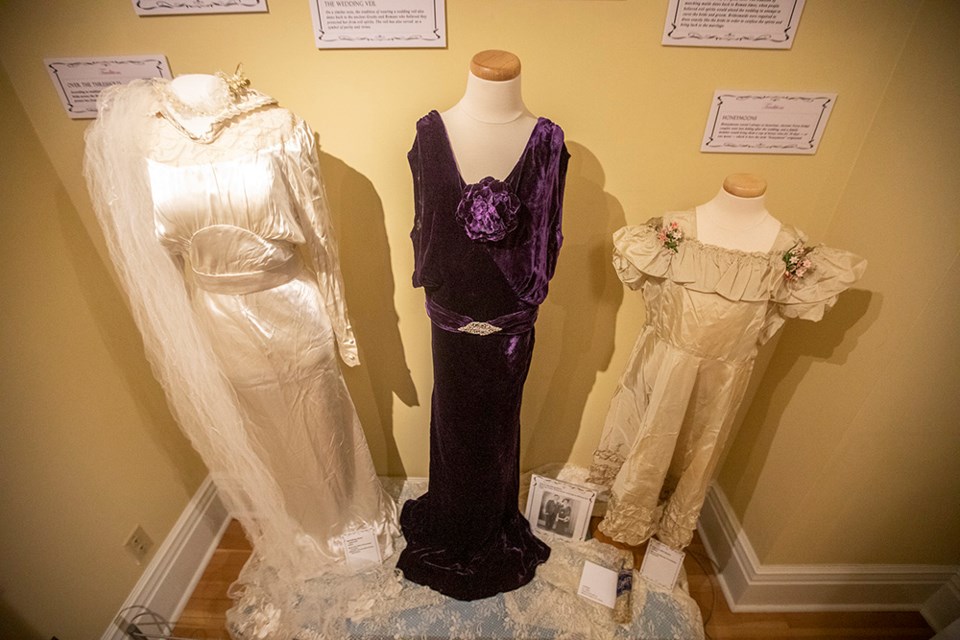Okotoks’ early residents were known to challenge each other at card parties, kick up their heels at community dances and lace up for a skate on the Sheep River back in the day.
We Made Our Own Fun is one of three new exhibits at the Okotoks Museum and Archives that discloses how the town’s first residents spent their free time around the turn of the 20th century. It’s located on the main floor.
“It is all about how early residents entertained themselves before the arrival of television,” said museum specialist Kathy Coutts. “It really focuses on how people had to come up with their own form of entertainment.”
Among the most popular pastimes were community dances, which were often held in a one-room schoolhouse or someone’s home, said Coutts.
“There are stories about pushing back the furniture and the living room becoming the dance hall,” she said. “There would be a live band as all the neighbours gathered together for an entertaining evening.”
Sport was another popular pastime for early residents – everything from organized sports like curling and hockey to unstructured recreation like skating on the river, sleigh rides and tobogganing, said Coutts.
“There’s a great story in the early days where kids would catch bobs - grab ahold of the rear of a wagon or a sleigh that belonged to a farmer and slide out of town, often unbeknownst to the fellow driving the wagon or the sleigh,” she said.
We Made Our Own Fun also pays tribute to the arrival of the radio and the television, and how they changed people’s lives.
Artifacts include a gramophone, skates, parlour games, turn-of-the-century books, cylinder records and musical instruments.
Coutts said the town had a community and marching band that would often participate in the Calgary Stampede Parade.
“Music was a great way to amuse residents in the early days,” she said.
Another new exhibit to the museum, located on the second level, is Love Stories in the Foothills, which features wedding traditions and stories of how people met in Okotoks’ early years.
“There’s a few panels on finding love in the midst of war and love stories from both world wars,” said Coutts. “There are stories that talk about the role community dances played in bringing couples together.”
Another popular event was box socials, where ladies prepared a lunch and decorated a lunch box or basket to be auctioned off in community fundraisers, said Coutts.
The successful bidder won both the lunch and an opportunity to dine with the woman who made it.
“A wife could create a basket, prepare a meal and she would hope that her husband would bid on her own,” she said.
The box socials were also an opportunity for single women to meet eligible bachelors, Coutts said.
“There’s a story from the Davisburg area where three bachelors were bidding on one basket so the price was going up,” she said. “There was a little rivalry there. Often it was anonymous so you didn’t know whose basket it was until the woman brought it over.”
Love Stories in the Foothills also educates visitors on the history behind traditions like garter belts, wedding veils and throwing the bouquet, and explains how couples often met in Okotoks’ early days.
“The most common way to meet was community dances,” said Coutts. “Okotoks had a lot of community dances in the early days.”
During the Second World War, several international pilots trained at the DeWinton Elementary Flight Training School so several women met their future husbands at the airport while they were training, said Coutts.
Artifacts in this exhibit include a purple velvet wedding dress worn by Evelyn Herr (nee Kadey) in 1925, a wedding dress worn by Gertrude Ardiel (nee Armitage) in 1907 and a flower girl dress from the 1940s. A third exhibit, Headstones, Hymn Books and Burial Traditions, is also located on the second floor.
Coutts said last year’s summer student, Caylee Dzurka, researched burial practices and developed a panel on the topic that includes the history of the Okotoks cemetery and traditional burial practices around the world.
It describes different headstone shapes and symbols and the meaning behind them.
“We’ve never done an exhibit on that before,” said Coutts. “We really value the research that Caylee did on this top because it’s quite fascinating.”
The Okotoks Museum and Archives is open Tuesdays to Saturdays from 10 a.m. to 5 p.m. Admission is by donation.




